7 Essential Tips to Make Authentic and Delicious Jajangmyeon at Home
Craving authentic Jajangmyeon at home? Unlock the secrets to delicious Korean black bean noodles with these 7 essential tips!
Table of Contents
Introduction
Jajangmyeon. Just the name conjures up images of steaming bowls filled with thick, chewy noodles, all generously coated in a rich, savory black bean sauce. Indeed, it’s the quintessential Korean comfort food, a dish that’s synonymous with birthdays, graduations, and casual gatherings. I fondly remember my first taste of Jajangmyeon from a small Korean restaurant – the unforgettable blend of savory, slightly sweet, and utterly addictive flavors immediately won me over. While ordering from your favorite restaurant is certainly convenient, recreating this iconic dish in your own kitchen is surprisingly achievable.
However, many home cooks find the process daunting, fearing they won’t be able to capture that authentic taste. But fear not! You can easily recreate Jajangmyeon, or Korean black bean noodles, at home with the right knowledge and techniques. This article provides 7 essential tips to achieve authentic and truly delicious results. Get ready to embark on a culinary adventure and impress your friends and family with your newfound Jajangmyeon skills! Prepare to unleash the restaurant quality dish that you and your loved ones will never forget.
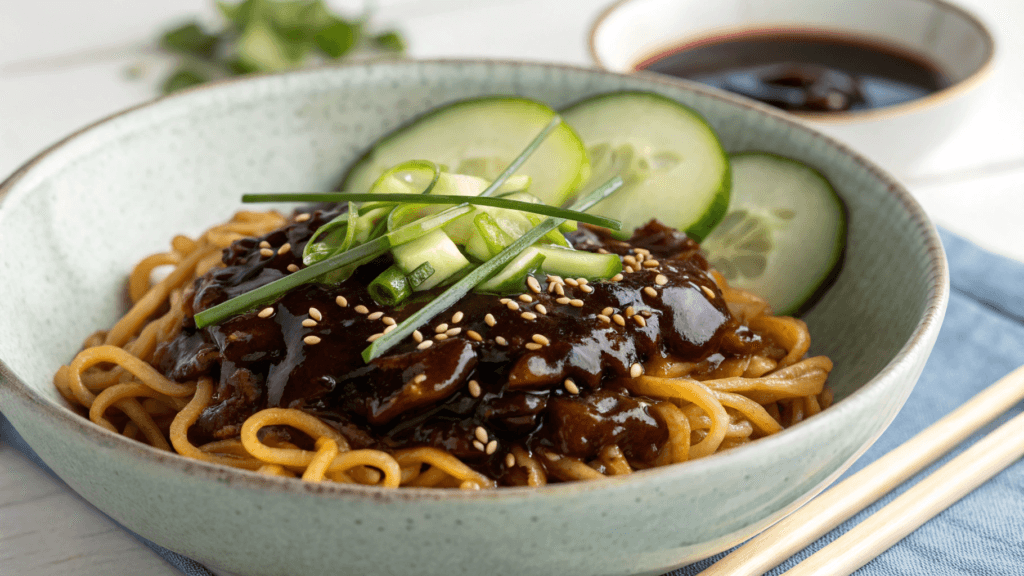
II. Understanding Jajangmyeon: More Than Just Black Bean Noodles
Jajangmyeon (자장면) is much more than just noodles with a black bean sauce topping. Instead, it’s a cultural icon in Korea, deeply embedded in its food history and traditions. Therefore, understanding its roots and key components is the first step toward creating an authentic version in your own kitchen.
- What is Jajangmyeon? A Deep Dive into its Origins
- The History of Jajangmyeon: From China to Korea
Jajangmyeon traces its roots back to Zhajiangmian, a similar noodle dish from Shandong province in China. Introduced to Korea in the late 19th century by Chinese immigrants in Incheon’s Chinatown, the dish underwent a significant transformation to suit Korean palates. As a result, it became a uniquely Korean creation. - The Evolution of the Dish: How it Became Uniquely Korean
The Korean version, Jajangmyeon, evolved by using chunjang, a Korean-style black bean paste, which has a distinct flavor profile compared to its Chinese counterpart. Over time, it became sweeter and less salty, aligning with Korean preferences. In addition, the addition of ingredients readily available in Korea cemented its place in Korean cuisine. This adaptation solidified its position as a beloved Korean dish.
- The History of Jajangmyeon: From China to Korea
- Key Components of Jajangmyeon: Noodles, Sauce, and Toppings
- The Noodle’s Role: Fresh vs. Dried, Thick vs. Thin
The noodles are undeniably the foundation. While both fresh and dried noodles can be used, fresh, thick wheat noodles are generally preferred for their delightfully chewy texture and ability to absorb the sauce. You can find these noodles at most Korean grocery stores, often labeled as “Jajangmyeon noodles.” The thicker the noodle, therefore, the better it holds the rich sauce. - The Heart of the Matter: Understanding Chunjang (Black Bean Paste)
Chunjang (춘장) is undeniably the star of the show. This fermented black bean paste gives Jajangmyeon its distinctive color and savory flavor. Made from wheat flour, soybeans, and caramel, it undergoes a fermentation process that develops its unique taste. Proper preparation is certainly crucial for optimal flavor, so pay close attention to the roasting process. - Beyond the Noodles: Exploring the Toppings (Meat, Vegetables, Seafood)
The toppings add texture and flavor complexity. Typically, Jajangmyeon includes diced chicken, onions, zucchini, and sometimes cabbage or potatoes. Seafood variations, with shrimp or squid, are also popular. The best toppings are, therefore, those that complement the rich sauce.
- The Noodle’s Role: Fresh vs. Dried, Thick vs. Thin
III. Tip #1: Choosing the Right Chunjang: Your Foundation for Flavor
The quality of your chunjang directly impacts the final flavor of your homemade authentic Jajangmyeon. Selecting and preparing it correctly is therefore crucial for authentic results.
- What is Chunjang? Demystifying the Black Bean Paste
- Ingredients and Production: How it’s Made
Chunjang is made by fermenting soybeans with wheat flour and caramel. The mixture is then aged, developing its characteristic dark color and complex, slightly bitter, and savory flavor. Indeed, the fermentation process is what gives it its distinctive character. - Different Brands and Varieties: Finding the Right One for You
Several brands of chunjang are available, each with subtle differences in flavor and intensity. Some popular brands include Sempio and Wang. Experiment to find your preferred brand. Generally, look for a paste with a deep, rich color and a smooth consistency. In addition, consider reading online reviews to see what other cooks prefer.
- Ingredients and Production: How it’s Made
- Preparing Chunjang: Roasting for Depth of Flavor
- Why Roast? The Importance of Caramelization
Roasting chunjang is essential to mellow its bitterness and enhance its savory notes. This process caramelizes the sugars in the paste, creating a deeper, richer flavor profile. Therefore, don’t skip this step! - Roasting Techniques: Stovetop vs. Oven
You can roast chunjang on the stovetop or in the oven. For stovetop roasting, heat a generous amount of vegetable oil in a wok or large pan over medium-low heat. Add the chunjang and stir constantly for 5-10 minutes, until it darkens slightly and releases a fragrant aroma. For oven roasting, preheat your oven to 350°F (175°C). Spread the chunjang on a baking sheet and roast for 15-20 minutes, stirring occasionally. Both methods work well; therefore, choose the one that’s most convenient for you. - Signs of Perfect Roasting: Color, Aroma, and Texture
Perfectly roasted chunjang will be darker in color, have a fragrant, almost nutty aroma, and a slightly smoother texture. Be careful not to burn it, as this will result in a bitter taste. So, keep a close eye on it during roasting.
- Why Roast? The Importance of Caramelization
- Storing Chunjang: Maximizing Shelf Life and Flavor
Once opened, store chunjang in an airtight container in the refrigerator. Properly stored, it can last for several months. In addition, make sure to label the container with the opening date.
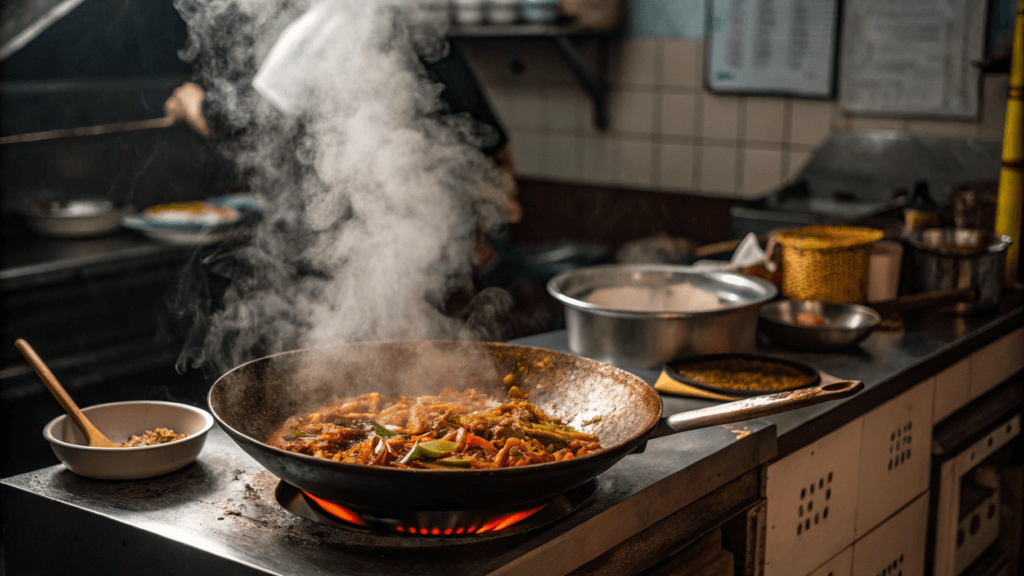
IV. Tip #2: Mastering the Art of the Sauce: Achieving the Perfect Balance
The sauce is where the magic happens. Achieving the right balance of flavors and consistency is undeniably key to Jajangmyeon perfection.
- The Base: Infusing Oil with Flavor
- Choosing the Right Oil: Vegetable Oil
Vegetable oil is the standard choice, but a blend of vegetable oil and sesame oil adds a subtle nutty aroma. The ratio can be adjusted to your preference, but a good starting point is 3 parts vegetable oil to 1 part sesame oil. In addition, be sure to use a high-quality oil for the best results. - Infusing with Aromatics: Ginger, Garlic, and Onion
Infuse the oil with aromatics like minced ginger, minced garlic, and diced onion. Sauté these ingredients in the oil until fragrant and slightly softened before adding the roasted chunjang. This infuses the oil with flavor, creating a more complex and aromatic sauce. So, don’t rush this step.
- Choosing the Right Oil: Vegetable Oil
- The Key to Umami: Incorporating Broth and/or Cornstarch Slurry
- Broth Options: Chicken, Vegetable
Adding broth enhances the umami (savory) flavor of the sauce. Chicken broth is a classic choice, but vegetable broth also works well, depending on your protein selection. In fact, using homemade broth will elevate the flavor even further. - The Role of Cornstarch Slurry: Thickening and Gloss
A cornstarch slurry (cornstarch mixed with cold water) is essential for thickening the sauce and giving it a glossy sheen. Add the slurry gradually, stirring constantly, until the desired consistency is reached. Therefore, mix the cornstarch and water well to avoid clumps. - Achieving the Right Consistency: Not Too Runny, Not Too Thick
The sauce should be thick enough to coat the noodles but not so thick that it becomes gloppy. Aim for a consistency similar to gravy. Adjust the cornstarch slurry accordingly to achieve the desired thickness.
- Broth Options: Chicken, Vegetable
- Balancing Flavors: Sweet, Salty, and Savory
- The Role of Sugar: Balancing Bitterness
Chunjang can have a slightly bitter taste, which is balanced by adding sugar. Start with a small amount and adjust to your liking. Brown sugar or white sugar can be used. So, taste the sauce frequently and adjust the sweetness as needed. - Soy Sauce: Adding Depth and Saltiness
Soy sauce adds depth and saltiness to the sauce. Use a good quality soy sauce for the best flavor. In addition, consider using low-sodium soy sauce to control the salt level. - Oyster Sauce (Optional): Boosting Umami
Oyster sauce is an optional ingredient that adds an extra layer of umami to the sauce. If using, add it sparingly, as it can be quite potent. Therefore, use it judiciously to avoid overpowering the other flavors.
- The Role of Sugar: Balancing Bitterness
- Flavor Enhancers: MSG and Other Options (Optional)
Some recipes call for a small amount of MSG (monosodium glutamate) to enhance the overall flavor. This is optional and can be omitted if preferred. Mushroom powder is a natural alternative to MSG. Indeed, mushroom powder provides a similar umami boost.
V. Tip #3: Selecting and Preparing Your Protein: From Chicken to Seafood
The protein you choose will contribute significantly to the overall flavor and texture of your Jajangmyeon, the perfect black bean noodles.
- Popular Protein Choices: Chicken, and Seafood
- Chicken: The Classic Choice
Chicken is a readily available and versatile option for Jajangmyeon. Its flavor pairs well with the savory black bean sauce. - Seafood Variations: Shrimp, Squid
Seafood variations, with shrimp or squid, offer a lighter and more refreshing option. In addition, they add a unique textural element to the dish.
- Chicken: The Classic Choice
- Preparing the Protein: Dicing, Marinating, and Cooking
- The Importance of Uniformity: Dicing Techniques
Dice the protein into small, uniform pieces to ensure even cooking. Moreover, this allows the protein to absorb the flavors of the marinade and sauce more effectively. - Marinating for Flavor: Soy Sauce, Ginger, Garlic, and Sesame Oil
Marinate the protein for at least 30 minutes (or longer, for more intense flavor) in a mixture of soy sauce, minced ginger, minced garlic, and sesame oil. This adds flavor and helps to tenderize the . Therefore, don’t skip the marinating step! - Cooking Techniques: Stir-frying to Perfection
Stir-fry the marinated protein in the infused oil until it is cooked through and slightly browned. In addition, be careful not to overcrowd the pan, as this can lower the temperature and result in uneven cooking.
- The Importance of Uniformity: Dicing Techniques
- Vegetarian/Vegan Options: Tofu and Mushrooms
For a vegetarian or vegan version, substitute the with firm tofu or a variety of mushrooms, such as shiitake or cremini. Marinate the tofu or mushrooms similarly to the meat for enhanced flavor. Therefore, pressing the tofu before marinating will help it absorb more flavor.
VI. Tip #4: The Vegetable Medley: Adding Texture and Freshness
Vegetables add essential texture, freshness, and nutritional value to authentic Jajangmyeon.
- Essential Vegetables: Onions, Zucchini, and Cabbage
- The Importance of Onions: Building the Flavor Base
Onions are a fundamental ingredient, contributing sweetness and building the flavor base of the sauce. In fact, the more onions you use, the deeper the flavor will be. - Zucchini: Adding a Mild Sweetness
Zucchini adds a mild sweetness and tender texture. In addition, it helps to balance the richness of the sauce. - Cabbage (Optional): Providing Crunch and Texture
Cabbage (typically Napa cabbage) provides a satisfying crunch and complements the other vegetables. If you prefer a softer texture, cook the cabbage for a longer time.
- The Importance of Onions: Building the Flavor Base
- Other Vegetable Options: Potatoes, Carrots, and Spring Onions
- Potatoes: Adding Body and Texture
Potatoes add body and texture to the sauce, making it more substantial. So, be sure to dice them small enough so they cook through. - Carrots: Contributing Sweetness and Color
Carrots contribute sweetness and add a pop of color. In addition, they provide a boost of vitamins and minerals. - Spring Onions: For a Fresh, Zesty Finish
Spring onions are typically added as a garnish, providing a fresh, zesty finish. Therefore, don’t skimp on the spring onions!
- Potatoes: Adding Body and Texture
- Preparing the Vegetables: Chopping and Stir-Frying
- Proper Chopping Techniques: Achieving Uniform Size
Chop the vegetables into small, uniform pieces, similar in size to the protein. Moreover, this ensures even cooking and a consistent texture. - Stir-Frying to Perfection: Maintaining Crispness and Preventing Soggy Vegetables
Stir-fry the vegetables in the same pan used for the protein, adding them in order of cooking time (e.g., onions first, followed by carrots, potatoes, zucchini, and cabbage). The goal is to maintain a slight crispness and prevent them from becoming soggy. In addition, stir-fry the vegetables over high heat for best results.
- Proper Chopping Techniques: Achieving Uniform Size
VII. Tip #5: Noodle Nirvana: Choosing, Cooking, and Serving Your Noodles
Choosing, cooking, and serving the noodles correctly is therefore crucial for the final texture and enjoyment of your Jajangmyeon black bean noodles.
- Fresh vs. Dried Noodles: Understanding the Differences
- Fresh Noodles: The Preferred Choice for Authenticity
Fresh, thick wheat noodles are the preferred choice for Jajangmyeon, offering a superior chewy texture and ability to absorb the sauce. In fact, many Korean cooks consider fresh noodles essential for authentic Jajangmyeon. - Dried Noodles: A Convenient Alternative
Dried noodles can be used as a convenient alternative, but they may not have the same chewy texture as fresh noodles. Therefore, look for thick, dried wheat noodles that are specifically designed for noodle dishes.
- Fresh Noodles: The Preferred Choice for Authenticity
- Cooking the Noodles: Achieving the Perfect Texture
- Boiling Techniques: Preventing Stickiness
Cook the noodles according to package directions, using plenty of boiling water to prevent stickiness. Moreover, adding a small amount of oil to the boiling water can also help prevent sticking. - Rinsing the Noodles: Removing Excess Starch
Immediately after cooking, rinse the noodles thoroughly under cold running water to remove excess starch. This prevents them from sticking together and helps them maintain their chewy texture. So, don’t skip this crucial step!
- Boiling Techniques: Preventing Stickiness
- Serving the Noodles: Hot, Fresh, and Ready to Enjoy
- Proper Plating Techniques: Arranging the Noodles and Sauce
Place the cooked noodles in a bowl and generously top with the prepared Jajangmyeon sauce. In addition, be sure to leave some of the noodles visible so they can be appreciated. - Garnish Options: Cucumber, Sesame Seeds, and a Fried Egg
Garnish with julienned cucumber for a refreshing crunch, sesame seeds for flavor and texture, and a fried egg (optional) for added richness and protein. Therefore, these garnishes elevate both the flavor and the presentation of the dish.
- Proper Plating Techniques: Arranging the Noodles and Sauce
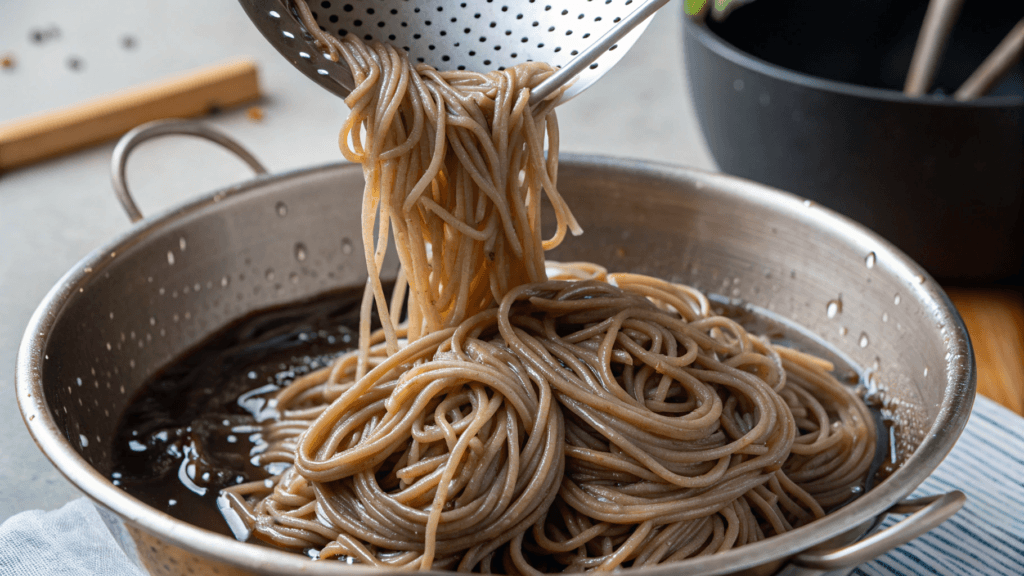
VIII. Tip #6: Assembling and Serving: The Final Touches
The final touches indeed make all the difference in a Jajangmyeon dish!
- Combining the Noodles, Sauce, and Toppings
- Proper Portioning: Finding the Right Ratio
Ensure a generous amount of sauce coats the noodles, but not so much that it becomes overwhelming. The right ratio is essential for a balanced flavor. - Mixing Techniques: Ensuring Even Distribution
Mix the noodles, sauce, and toppings thoroughly to ensure even distribution. This ensures that every bite is packed with flavor.
- Proper Portioning: Finding the Right Ratio
- Garnishing: Adding Visual Appeal and Flavor
- Cucumber: A Refreshing Addition
Julienned cucumber adds a refreshing crunch and visual appeal. The cool cucumber contrasts beautifully with the rich, warm sauce. - Sesame Seeds: For Flavor and Texture
Sesame seeds provide a nutty flavor and added texture. Toasting the sesame seeds before adding them enhances their flavor even further. - Fried Egg (Optional): Adding Richness and Protein
A fried egg, preferably with a runny yolk, adds richness and protein to the dish. The yolk mixes with the sauce to create an even creamier texture.
- Cucumber: A Refreshing Addition
- Serving Immediately: Enjoying Jajangmyeon at its Best
Jajangmyeon is best enjoyed immediately after preparation, while the noodles are still hot and the sauce is flavorful. Therefore, serve it right away for the optimal dining experience.
IX. Tip #7: Troubleshooting and Customization: Making Jajangmyeon Your Own
Don’t be afraid to experiment and make Jajangmyeon your own. In fact, this is where you can truly personalize the dish to your liking.
- Common Mistakes and How to Avoid Them
- Sauce Too Bitter? Add More Sugar.
If the sauce is too bitter, add more sugar to balance the flavor. Taste as you go and adjust accordingly. - Sauce Too Runny? Thicken with Cornstarch Slurry.
If the sauce is too runny, thicken it with a cornstarch slurry. Add it gradually, stirring constantly, until you reach the desired consistency. - Noodles Too Sticky? Rinse Thoroughly.
If the noodles are too sticky, rinse them more thoroughly under cold water. This is a crucial step that should not be skipped.
- Sauce Too Bitter? Add More Sugar.
- Customization Options: Adjusting the Recipe to Your Preferences
- Spice Level: Adding Gochugaru or Chili Oil
Add gochugaru (Korean chili powder) or chili oil for a spicier kick. Start with a small amount and adjust to your liking. - Vegetarian/Vegan Variations: Experimenting with Tofu and Mushrooms
Experiment with different types of tofu and mushrooms for vegetarian/vegan variations. Each type will add a unique flavor and texture to the dish. - Seafood Lovers: Adding More Shrimp or Squid
Add more shrimp or squid for a seafood-focused dish. In addition, consider adding other types of seafood, such as mussels or clams.
- Spice Level: Adding Gochugaru or Chili Oil
- Beyond Jajangmyeon: Related Korean Noodle Dishes (Brief Mention)
- Jjampong: Spicy Seafood Noodle Soup
Jjampong is a spicy seafood noodle soup, often served alongside Jajangmyeon. If you enjoy Jajangmyeon, you’ll likely enjoy Jjampong as well. - Udon: Thick Wheat Noodles
Udon noodles can be used in various Korean dishes. Their thick, chewy texture makes them a versatile ingredient.
- Jjampong: Spicy Seafood Noodle Soup
Jajangmyeon Recipe: Step-by-Step Guide
Now, let’s dive into a detailed Jajangmyeon recipe that you can easily follow at home.
Ingredients:
- 1 pound fresh Jajangmyeon noodles
- 1/2 cup Chunjang (Korean black bean paste)
- 2 tablespoons vegetable oil
- 1 tablespoon sesame oil
- 1 cup diced chicken
- 1 medium onion, diced
- 1 zucchini, diced
- 1/2 cup diced cabbage
- 1/2 cup chicken broth
- 1 tablespoon sugar
- 1 tablespoon soy sauce
- 1 teaspoon cornstarch
- 2 tablespoons cold water
- 1 teaspoon minced ginger
- 2 cloves garlic, minced
- 1 cucumber, julienned (for garnish)
- Sesame seeds (for garnish)
- 2 eggs, fried (optional)
Step-by-Step Instructions:
- Roast the Chunjang: In a wok or large pan, heat the vegetable oil and sesame oil over medium-low heat. Add the Chunjang and stir constantly for 5-10 minutes, until it darkens slightly and releases a fragrant aroma. Remove from heat and set aside.
- Prepare the Chicken: In a bowl, marinate the diced chicken with soy sauce, ginger, and garlic for at least 30 minutes.
- Stir-Fry the Vegetables: In the same wok or pan, stir-fry the onion until softened and translucent. Add the zucchini and cabbage and stir-fry until slightly tender.
- Add the Chicken: Add the marinated chicken to the pan and stir-fry until cooked through.
- Add the Roasted Chunjang: Add the roasted Chunjang to the pan and stir-fry for 1-2 minutes, coating the chicken and vegetables evenly.
- Add the Broth and Sugar: Pour in the chicken broth and add the sugar. Stir well to combine. Bring to a simmer.
- Thicken the Sauce: In a small bowl, mix the cornstarch with cold water to create a slurry. Gradually add the slurry to the pan, stirring constantly, until the sauce thickens to the desired consistency.
- Cook the Noodles: Cook the Jajangmyeon noodles according to package directions.
- Rinse the Noodles: Immediately after cooking, rinse the noodles thoroughly under cold running water to remove excess starch.
- Assemble and Serve: Place the cooked noodles in a bowl and generously top with the prepared Jajangmyeon sauce.
- Garnish: Garnish with julienned cucumber, sesame seeds, and a fried egg (optional).
- Mix and Enjoy: Mix everything thoroughly and enjoy your homemade Jajangmyeon!
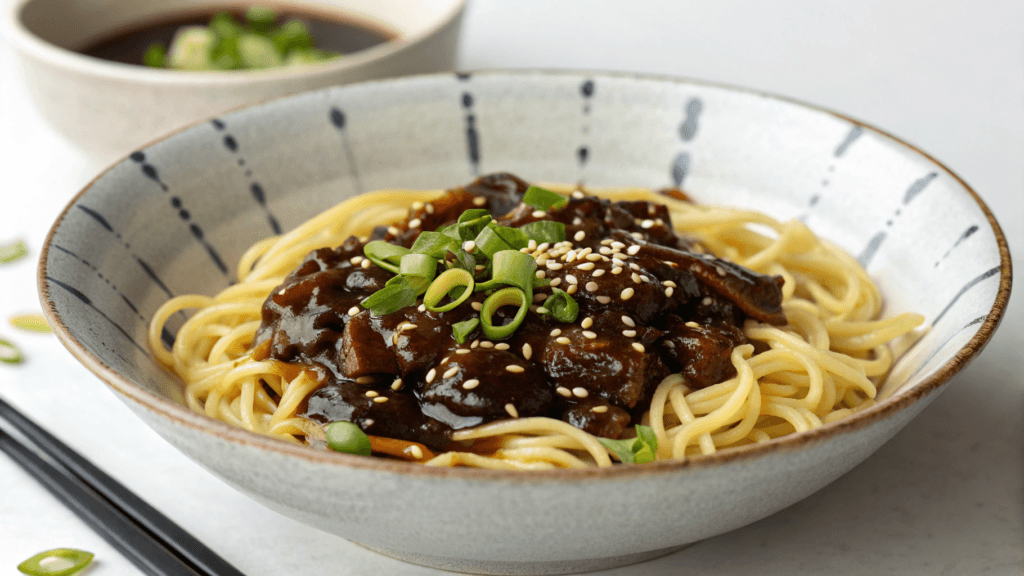
Nutritional Information (per 100g)
| Nutrient | Amount |
| Calories | 150 |
| Protein | 8g |
| Fat | 5g |
| Carbohydrates | 20g |
| Fiber | 2g |
| Sugar | 4g |
| Sodium | 300mg |
X. Conclusion
Mastering Jajangmyeon at home is indeed within your reach! By following these 7 essential tips – choosing and roasting the right chunjang, mastering the sauce for authentic korean black bean noodles, selecting your protein and vegetables carefully, cooking your noodles to perfection, assembling with care, and troubleshooting common issues – you’ll be able to create authentic and delicious Jajangmyeon that rivals your favorite restaurant. Don’t be afraid to experiment and adjust the recipe to your own taste preferences. Therefore, embrace the culinary adventure and create your own signature Jajangmyeon!
Now it’s your turn! Leave a comment below and let me know what you think. Share this article with your friends and family, and explore other delicious Korean recipes on our website. Enjoy your homemade Jajangmyeon – a taste of Korea in your own kitchen!
FAQ Section:
Q: What is Jajangmyeon?
A: Jajangmyeon is a popular Korean noodle dish featuring thick wheat noodles covered in a rich, savory black bean sauce. It’s often enjoyed as a comfort food and is a staple in Korean cuisine.
Q: What is the best Jajangmyeon recipe?
A: The best Jajangmyeon recipe involves using high-quality ingredients, roasting the Chunjang (black bean paste) properly, and balancing the flavors of the sauce to your liking. This article provides a detailed recipe and essential tips for creating a delicious, authentic version at home.
Q: Where can I find Jajangmyeon near me?
A: Jajangmyeon is commonly found in Korean restaurants, particularly those specializing in Chinese-Korean cuisine. You can also check online food delivery platforms to find local restaurants that offer Jajangmyeon.
Q: What is Jajangmyeon sauce made of?
A: Jajangmyeon sauce is primarily made from Chunjang (Korean black bean paste), vegetable oil, broth, sugar, soy sauce, and a cornstarch slurry for thickening. Additional ingredients like onions, garlic, and ginger enhance the flavor.
Q: What are the best Jajangmyeon noodles?
A: The best Jajangmyeon noodles are thick, fresh wheat noodles, which provide a chewy texture and absorb the sauce well. These can be found at most Korean grocery stores. Dried noodles can be used as a convenient alternative.
Q: What are the key Jajangmyeon ingredients?
A: The key Jajangmyeon ingredients include Jajangmyeon noodles, Chunjang (Korean black bean paste), chicken (or other protein), onions, zucchini, cabbage, broth, sugar, soy sauce, cornstarch, ginger, and garlic.
Q: I’m visiting Jajangmyeon Paris, where can I get the best one?
A: To the best of my knowledge, I don’t have details about the restaurants in Jajangmyeon Paris, it’s best to do a quick online search for Korean restaurants that have this dish!
Q: Can I make instant Jajangmyeon?
A: Yes, instant Jajangmyeon is available and offers a convenient way to enjoy the dish. However, it lacks the depth and complexity of homemade Jajangmyeon. You can find instant versions at most Korean grocery stores or online retailers.
Cooking is an act of love and creativity! 🌟 What do you think of this recipe? I’d love to hear your thoughts and any tips or tweaks you’d suggest to make it even better. Let’s inspire each other in the kitchen!
There are no reviews yet. Be the first one to write one.




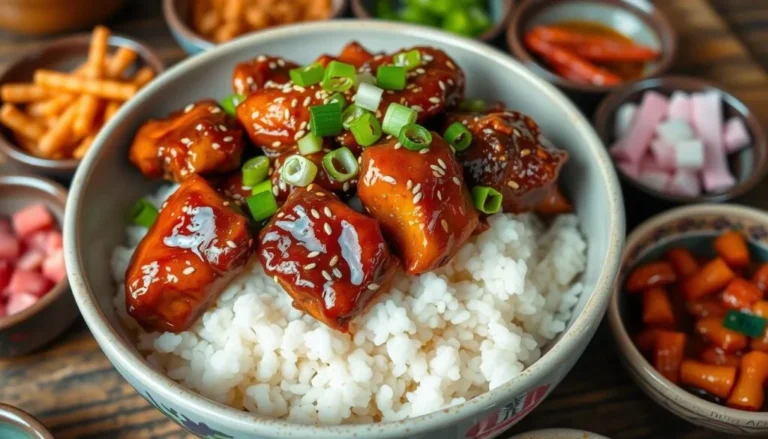


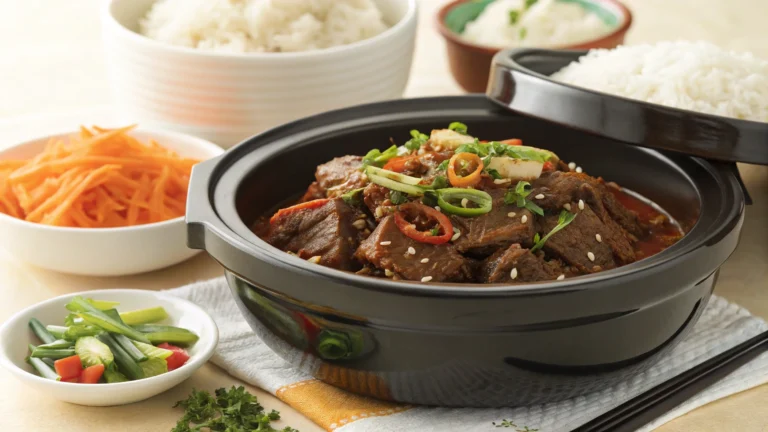

One Comment